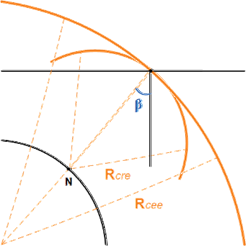MultiFocusing technology is proprietary and patented Geomage development.
MultiFocusing can dramatically improve the quality of seismic imaging especially in cases of low fold data, poor signal- to- noise ratio and sparse 3D acquisition. At the same time, local parameters of the observed wavefield in prestack seismic records are of great interest for many seismic applications such as signal enhancement, velocity model building etc.Time imaging usually constitutes a key first step that facilitates the estimation of a velocity model for depth imaging even for complex areas that require depth migration for correct subsurface imaging. For these reasons, improving the quality of time imaging is a focus of intensive research. A recent advance is MultiFocusing (MF), a method with the potential to greatly improve the quality of time imaging.
In contrast to the procedures of CMP based methods, in the zero-offset MF approach proposed by Berkovitch et al. (1994) and described in details in Berkovitch et al. (2008) and Landa et al. (2010), each zero-offset trace is constructed by stacking traces that need not belong to the same CMP gather but, rather, whose sources and receivers are within the limits of a certain aperture in the vicinity of the central (imaging) point. The size of such an aperture is determined by the size of the first Fresnel zone. The number of traces falling in this zone can significantly exceed the number of traces belonging to one CMP gather. This allows a considerable increase in the signal-to-noise ratio for the target reflection. Since the traces being stacked no longer belong to the same CMP gather, this procedure requires a more general moveout correction than the one used in conventional CMP stacking. For a given source-receiver pair, the MultiFocusing moveout equation is based on the spherical approximation of the reflection event’s wavefront near the observation surface. The moveout correction expressed by the zero-offset MultiFocusing (ZOMF) formula is, in the 2D case, a three-parameter surface which accurately approximates the actual traveltime in the vicinity of the imaging point. The three parameters are: the emergence angle of the normal ray β and the radii of curvature Rcre and Rcee of the two fundamental wavefronts, namely, normal incident point and normal waves respectively.
One of the main limitations of the Zero-Offset MF (ZOMF) method is a quasi-hyperbolic approximation for actual travel-time surfaces. The MF operator in this case is constructed around a zero-offset ray and, in principle, is valid for short offsets. Yet, ZOMF approach can be a viable tool for initial estimation of velocity corridor as well as in media where multiple energy wavefront parameterization is rapidly changes along the different offsets, creating for COMF technology a major obstacle to approximate accurately a primary energy wavefront parameters at each common-offset range.
Later on a generalization of the Zero-Offset MF correction for the arbitrary offset case was introduced. This new time correction was named as Common-Offset MultiFocusing (COMF). There are a number of possible applications of the COMF such as non-hyperbolic time imaging, prestack signal enhancement, AVA, stereotomography, etc that are greatly benefit from this more generalized approached.
MultiFocusing technology
MF technology, based on multiparameter analysis of the wavefield and summation along predicted time surfaces, has been applied to enhance time imaging sections by dramatically increasing the fold of coherent summation of seismic signals. The MF correction formula is quite accurate, even for strongly curved reflectors and moderate lateral velocity variations. This can be attributed to the fact that it is not a simple hyperbolic Taylor expansion, but a double square-root equation. Implementation of the MF method is technically challenging because it requires estimation of three moveout parameters in the 2-D case and eight in the 3-D case (see figures below), as opposed to a single parameter (stacking velocity) in standard normal moveout velocity analysis. It is achieved by simultaneously analyzing a super-CMP gather consisting of a number of CMPs. Although, in principle, “mixing” reflection events from a number of CMPs might compromise the spatial resolution of the resulting stacked section and make random noise appear as an interpretable signal, our implementation of a simultaneous parameter search mostly avoids this effect and minimizes artifacts.
Key potential benefits of MF stacking, as compared to the CMP stack, include:
• Stacking a large number of traces covering many CMP gathers that can increase the stacking power and signal-to-noise ratio;
• A moveout correction that is “stretch-free,” which dramatically increases vertical resolution and essentially can contribute to wide-angle amplitude versus offset analysis; and
• A moveout correction formula that accurately describes travel-time behavior for a wider class of subsurface models.

2D wave-front parameters

3D wave-front parameters